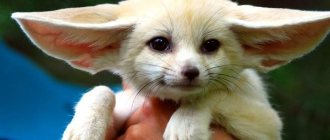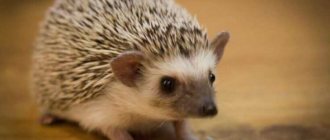Description and features
Serengeti cats visually resemble servals - just as muscular, graceful and wildly beautiful. There is sophistication in every movement, which is due to the long limbs and chiseled neck. The large ears sticking out on the top of the head immediately catch the eye. Because of this, the animal seems to be constantly on guard.
Likes to play
Their fur is soft and silky, mostly spotted in color. The size of cats is also impressive - adult cats gain up to 10 kg (sometimes much more). The breed is special not only in its external description, but also in its behavior and temperament. Cats are distinguished by increased self-confidence and equanimity, and developed intelligence. All this is combined with tenderness and affection towards the owner and members of his family.
But the Serengeti is not suitable for everyone to keep at home. It's all about their excessive "talkativeness", curiosity, hyper-mobility and persistence. They need a lot of attention, otherwise they will beg for it annoyingly.
Serengeti cats are very energetic
, but they do not conflict with other pets. However, they will always strive to take a leadership position. Against this backdrop, clashes often occur, especially with dogs.
Feed and health
It is recommended to use high quality food, although a natural method of feeding your cat is also suitable. However, too soft food is fraught with the appearance of tartar.
On average, the Serengeti lives 12-15 years, remaining active into old age and maintaining leadership qualities. Adults give birth to 3-8 kittens. This amount of offspring is quite rare for purebred species.
History of origin
The closest relative of Serengeti domestic cats is the African predator Serval. It is a mixture of lynx and caracal, but more closely resembles a cheetah. At home, they are tamed and kept in farmsteads, but with safety precautions in place.
Serval
Breeders have not lost hope of creating a small cat, identical to the Serval, but with an easy-going disposition. Attempts have been made to cross wild representatives with domestic ones. As a result, the Savannah breed appeared. There was no continuation, since many problems arise with their breeding. The first males are mostly sterile. Also, in the absence of an infusion of wild serval blood, cats lose their original characteristics over time.
Savannah cat, obtained by crossing a Serval and a domestic cat
American Karen Sauzman took a different path. She made an attempt to crossbred purebred domestic cats, similar in appearance to a serval. Preference was given to Bengals and the Oriental Shorthair breed. From the first it was planned to take large dimensions, rich color, from the second - slender legs, large ears and sophistication in habits. Both of them have pronounced spotting, which was also useful. Then other breeds were involved: Abyssinian, Maine Coon.
On a note! The first Serengeti were born in 1994. The breed was named after a reserve in Tanzania, where servals and many other game live.
The Serengeti breed is still young, experiments on it do not stop. It has not yet received official status, but is recognized by the TICA association. He cannot participate in exhibitions, because a limited number of catteries are engaged in breeding cats (at least 50 are required).
Where to buy a kitten?
This is actually a difficult question. After all, there are no nurseries in Russia yet, but there are only one or two of them in the world. At the same time, the Serengeti is already known in our country. The thing is that large Russian nurseries can purchase a Serengeti kitten on order especially for you from their colleagues abroad, but the price will be rather high.
If this doesn’t scare you and you decide to get a pet of one of the rarest breeds, but still decide to monitor prices, be careful, you may encounter scammers. It is better to buy such a rare cat through trusted people. See also rare cat breeds with photos and names.
The Serengeti is a unique cat breed that combines the wildness of the American savannah, extraordinary flexibility and grace, as well as tenderness and devotion to its owner. See also all photos of the Savannah cat breed.
Popular kennels for this breed:
- Russia - (your nursery is here);
- Belarus - (take place);
- Ukraine - (submit an application).
Breed standard
What the Serengeti should look like according to the standard:
| Head | In the form of an elongated wedge, smoothly expanding from the nose to the ears. The cheekbones and whiskers are not prominent. The chin is well developed. |
| Ears | This is the “calling card” of the Serengeti. They are large - the height corresponds to the length of the muzzle. Set high, with a short distance between them. The shells are wide and recessed at the base, gradually narrowing and forming rounded ends. |
| Nose | Smooth, the same width throughout with a black “patch”. |
| Neck | Elongated, quite thick. Its diameter increases from the skull to the body. |
| Eyes | Small and round, but not convex. They are quite far from each other. Golden-green and dark brown shades of the iris are preferred. |
| Body | Harmoniously built, muscular, strong. Smooth back line. Males are much larger than females. |
| Limbs | Long, slender, strong. Paw pads are oval. |
| Tail | It can be of different lengths, but it is preferable that it reaches the shoulder. It is wider at the base and tapers towards the tip. Must end with a black border. |
| Wool | Short, dense, soft and silky to the touch. The undercoat is completely absent. The guard hairs are clearly visible. |
Prominent ears will come to cats of the Serengeti, a wary look
Acceptable colors
The standard provides for “wild” spotted colors of cats. The most common color of the Serengeti is tabby. This is any shade of brown with a strong contrast between the spots and the main background. Such cats have a white chin, muzzle and lower abdomen. On the ears of animals of this color there is a clear “wild” spot that resembles a fingerprint.
No less common among the Serengeti are the so-called Silver/Smoke cat colors. In the first case, there are contrasting markings on the pure silver body of the animal. In the second, there is a ghostly pattern on a smoky background.
Solid colors are a little less common. Contrasting spots appear on the black body of such animals.
Serengeti cat color
The standard allows for several coat color options on the Serengeti. The most common:
- spotted tabby;
- black;
- brown;
- silver-gray.
The spots on the body should be round or slightly elongated horizontally, and the tail should be striped. On the woolly side of the ears there should be a specific pattern, like on the pads of human fingers.
Color silver-gray
Colors
According to the standard, the spots of this breed are round and oval in shape and located horizontally.
There are several standard colors of the Serengeti breed:
- Black tabby (spotted). The color of the spots is bright, contrasting with the main color.
- Black. In these cases, the color of the animal is darker, the markings are bright, but do not stand out strongly against the main color of the coat.
- Gray-smoky. The coat color is gray, the spots are black.
Personality of Serengeti cats
Unlike their wild “twins” the Servals, the Serengeti are friendly and open to communication. They quickly become attached to their owner and follow him around the house relentlessly. If you deprive your cat of attention, she will persistently beg for it, trying in every possible way to make herself known: rubbing herself, laying on the keyboard, resting on her legs and resorting to other tricks.
The Serengeti does not tolerate being left alone for long periods of time. Rough treatment is alien to them. If they are treated poorly, they will grow into an aggressive and embittered animal.
Serengeti are intellectuals by birth, which, along with their stubbornness, causes a lot of trouble. If they are planning to do something, no prohibitions will stop them - they will find a way to do it their own way. They should not be spoiled too much, because in this regard cats are insatiable and begin to become impudent.
Serengeti are extremely inquisitive and active, easy to train
They are leaders by nature, so they get along with other pets only if they recognize them as a commander. They will desperately defend their championship until they achieve what they want. They are fearless and will not shy away even from a large dog. They are ready to be the first to fight when their owner is in danger.
They cannot remain calm for a long time; they constantly find active activities. Their playfulness and perkiness benefit children. You will never get bored with such a pet. Any object turns into a toy for them.
Favourite cat
The house must have special structures for cats to climb and jump on.
List of vaccinations
To avoid dangerous diseases, pets must be vaccinated. If you adopt a cat from a cattery, most of the vaccinations have already been completed. In this case, a list of further vaccinations is given, if necessary.
If you buy a kitten from your own hands, then it needs to be vaccinated:
- against helminths and other parasites;
- complex vaccination against rhinotracheitis, calicivirus;
- repeat complex vaccination (2 times);
- against rabies.
Further vaccination is carried out according to the schedule. Vaccination against parasites is carried out as needed, the rest – once a year.
Defects in appearance
Work on this breed is still ongoing, and therefore the standards have not yet been officially recognized by international associations of animal lovers. But the defects of the breed include the following:
- two-color spots of unclear outlines;
- spotted inclusions transforming into stripes on the sides;
- squatness;
- light weight;
- limbs not long enough.
It is acceptable to have a light inclusion in the chest and groin area. But snow-white “pants”, the absence of a black tip on the tail and whitish spots on the body are grounds for disqualification. Blue eyes are also not welcome.
Breeding
Large cats mature a little later than other breeds. Thus, the first heat of a Serengeti female begins at 8 months, but individuals who have reached one and a half years of age are allowed to mate. Representatives of this breed can be crossed with each other, and mating with Bengals, Orientals and Abyssinians is also allowed. However, the Serengeti cannot be crossed with servals and wild cats. Kittens from such litters will not resemble this breed or will be infertile.
The date for the animals is arranged on the cat's territory. The animals get to know each other for about a day, and then begin mating games. Pregnancy lasts approximately 65–66 days. Kittens are born large - weighing 120–140 g. There are 3–5 cubs in one litter. Breeders hand over babies to new owners at the age of 3–4 months. Vaccination, training kittens to a tray and a scratching post falls on their shoulders.
Such cats grow up quite late
You cannot breed a cat more than once a year. Pregnancy and lactation greatly deplete the body. Full recovery takes on average 10 months.
Tendency to diseases
Like other mustachioed pets of the Serengeti, they can get sick from time to time. This is influenced by a number of factors: nutrition, care, living conditions, timeliness of vaccination. But in general, the breed has good immunity.
The Serengeti are predisposed to hereditary disorders of the genitourinary system. The symptoms are:
- difficulty urinating;
- bloody discharge in the urine;
- relieve yourself past the tray.
In this situation, you need to contact a veterinarian; self-medication is unacceptable.
Signs of a cat's disease
Diseases
The Serengiti is a strong breed in itself and lives for 12-15 years, but a lot depends on the conditions in which you will keep it. They have a certain tendency to form stones and in general: their genitourinary system is their only weak point. Moreover, males, rather than females, begin to suffer from this disease earlier and more often. Symptoms: the animal often runs to the toilet, but it is clearly painful for him to urinate. It sits “on the potty” for a long time, drops or blood clots are noticeable in the urine. Reason: hypothermia, trauma, improper feeding (excess fish in the diet or lack of water). Don't put off visiting your doctor!
Deworming and vaccination should be carried out regularly, even if your cat only walks indoors. Parasites can easily enter his body through raw meat or water, and you can bring home pathogens of such dangerous diseases as rabies or panleukopenia on your own street shoes or hands.
Stroke the cat with unwashed hands and voila! — as soon as she licks her fur, the pathogens will begin their attack.
Castration and sterilization are a common condition of sale. The operation is carried out no earlier than 7-9 months, when the process of puberty has not yet come to an end, and the body can already endure such a serious procedure. In females, this is best done immediately after the first heat. During the operation, anesthesia and self-absorbing sutures are used.
If you want to castrate an adult animal, remember: your pet, most likely, even after the operation, will retain the habit of shouting in a bad bass voice at the appropriate time and pedantically marking corners. So it’s better not to put off your plans.
If you dream of getting offspring, wait until your cat reaches the age of 1 year: by this time she will have already gone through 2-3 heats and her hormonal levels will have stabilized. The same deadline is set for cats. A cat that gives birth more than 2 times in 3 years quickly gets tired, begins to get sick and dies early. During pregnancy, a cat gives birth to from 3 to 8 kittens. A partner should be chosen carefully, studying documents and pedigree, and preferably an experienced one. Professionals breed Serengiti cats with Oriental cats and Bengals.
Care and maintenance
Due to the activity of the Serengeti, they would be better off in a spacious cottage with a large outdoor area. There they will be able to run freely and also hunt small animals (birds, rodents). But they also take root well in apartments. By letting them go outside alone, you don’t have to worry, they won’t run away forever.
Serengeti like to move along branches and hunt birds
If you accustom a kitten to a leash from childhood, then in the future the cat will not resist it on walks with its owner.
Serengeti are not picky about their care. Standard procedures:
- Regular examination of the eyes and ears to detect discharge. Remove them with a swab soaked in warm water.
- Combing the coat once every 2 weeks. Due to its thickness and shortness, tangles do not form. But such a procedure will serve as a massage for the skin. To do this, use a rubber brush.
- Swimming, if necessary. Cats are capable of keeping themselves clean, so bathing procedures are only needed when they are very dirty.
- Teeth brushing is required if your pet is fed soft food. This often provokes the formation of tartar. To do this, buy special toys and treats at the pet store.
To prevent your pet from scratching the furniture, it is advisable to install a scratching post. Then the cat will grind its claws down on its own. A special tool is used to cut them.
Trim the claws carefully so as not to injure the animal.
On the bed
Nutrition
Serengeti can be fed both natural food and industrial cat food (dry, canned). The main thing is to choose one thing. In the second case, preference is given to premium food that contains all the useful substances for the full development of the animal.
Full bowl
Professional feed formulations guarantee your pet complete and balanced nutrition
If natural products are a priority, then the menu is compiled with the participation of a veterinarian nutritionist. Food must be of high quality, fresh and prepared separately. Most of the diet should include meat (veal, beef, chicken, turkey). In addition, the following products are recommended:
- fresh vegetables;
- chicken eggs;
- cereal porridge;
- fermented milk products.
Additionally include vitamin and mineral substances , sold separately.
Salt, sweets, and spices are completely excluded from the list. Fried foods and smoked foods, baked goods, and bony fish are also unacceptable.
The Serengeti is not prone to overeating. So you can leave food in the bowl, your pet won’t eat too much.
In fact, it is enough to feed adult representatives twice. Babies up to six months and pregnant women are fed up to 4-5 times.
With a kitten
Breeding
Cats reach sexual maturity by one year. Even if the female comes into heat earlier, it is better to wait until the hormonal levels stabilize. Breeders advise resorting to mating no more than 2 times every 3 years . After giving birth, the animal needs about 10-11 months to fully recover. With frequent births, the cat’s body is depleted, which can lead to a shortened lifespan.
It is better to choose a partner in professional nurseries (in America or Great Britain). It's good if the cat is already untied.
Before such a significant event, both animals are shown to the veterinarian to rule out any diseases. It is preferable to perform mating on the territory of the “groom”. The cat is brought to him and left for several days (maximum 6-7).
Looks like I noticed something
Castration and sterilization
If the owner does not have serious plans to breed the Serengeti breed at home, then it is better to castrate the pet. This way you will be able to avoid marks of your apartment, screams and inappropriate behavior of the cat. At the same time, an animal deprived of sexual instincts and the regular hormonal surges associated with this becomes more intelligent, calm and happy, while being in the grip of unsatisfied desires, it experiences unnecessary torment. Some owners in vain compare instincts with human feelings, believing that castrated cats are deprived of love. This is not love, but a physiological process of mating based on instincts, and cats can do just fine without it. Moreover, sterilized animals suffer less from cancer and live longer.
At what age is it recommended to have surgery?
Doctors recommend castrating the animal at 7–9 months. On the one hand, at this age the body is already sufficiently formed, on the other hand, the process of puberty has not yet been completed. It is advisable to perform the operation on a cat before the first heat or immediately after it. Some breeders castrate their pets much earlier, before the age of 3-4 months, and claim that information about the dangers of early castration of animals is classified as outdated myths.
Castration can be performed at home or in a clinic. Thanks to modern advances in medicine, the operation is quick and does not pose a threat to the health of the animal. If you castrate an adult animal that has already shown signs of sexual behavior, some of this behavior may persist after the operation. That is, the cat can continue to mark corners in the apartment or organize concerts. To avoid this, castration must be carried out in a timely manner.
Caring for your pet after surgery
The operation is performed under anesthesia and the owner’s main task is to monitor how the animal wakes up and behaves after anesthesia. If you are cold, warm them up and give them drinks in small portions, but feeding them on the day of surgery is not recommended - this can cause vomiting. If your pet persistently licks the wound, you will have to put on a special collar (Elizabethan) and wear it for at least two or three days, until the incisions heal.
The seams will need to be treated for several days with products recommended by a veterinarian - most often this is ordinary brilliant green. Nowadays they use self-absorbing sutures, so they don’t even need to be removed. In about a week the animal will fully recover.
Price
Since the Serengeti breed is rare and is not bred in Russia, the price for kittens is high. You can buy a baby at a nursery for 1000-2000 dollars.
On a note! Trying to save money, many people purchase Serengeti from random advertisements. As a result, they get not a purebred representative, but a crossbreed. That is why it is so important to have the appropriate documents.
Everyone is blue-eyed
Nutrition
If you make a choice in favor of industrial feed, then representatives of the Serengeti breed should be fed ready-made dry mixtures of the super-premium or holistic class. They are well saturated and contain various vitamins, minerals and amino acids. Since these are large animals, they need to receive approximately one and a half times more calories than representatives of other breeds.
An adult cat should be fed 2 times a day at the same time, and kittens, depending on age, from 3 to 5 times a day.
Serengeti cats require more food than regular cats
Among the owners of purebred cats, there are those who prefer to prepare their diet from natural products. In this case, 70–80% of the total food volume should be meat and offal. Choose low-fat varieties - poultry fillet, beef tenderloin, veal, rabbit. Heart and stomachs can be given 2 times a week.
The remaining 20% of the diet is supplements, such as cereals, vegetables, eggs, and dairy products. You can treat your pet to a piece of cheese, shrimp, fish, and liver once a week. It is forbidden to feed cats fried, spicy, salty foods, sweets, bones, mushrooms, beans, and bread. Don't give bones or whole milk.
Choosing a kitten
Due to the lack of a fixed standard for the Serengeti breed, problems often arise with choosing a kitten. Many people rely only on photos. To avoid mistakes, it is recommended to seek help from a professional.
Handsome cat
Typically, they are guided by the following signs in an animal:
- good health;
- clean eyes and nose;
- without pathologies of the limbs, spinal column and tail;
- fatness, activity, sociability.
The baby you are purchasing must have routine vaccinations. Kittens bought from foreign nurseries have chips (this is written down in the passport).
What's prohibited
Has official status in TICA (International Cat Association).
But due to the fact that at the moment the conditions (at least 50 nurseries) under which the breed is allowed for exhibitions are not met, they are not exhibited.
Interesting Facts
There are a lot of interesting things to tell about the Serengeti. Here are some fun facts:
- These cats are far from silent creatures; they constantly make different sounds (growling, yapping, purring, hissing, clicking). That's why they are often called "talkers." This is how they talk to others. Sometimes it gets very tiring.
- The Serengeti are selflessly devoted to one person - the owner. This quality is akin to a dog's fidelity. In case of imminent danger, they are ready to immediately rush to defense. Just before this they let out a loud war cry.
- These cats are very jumping, able to overcome heights of 2 meters or more. So it is better to keep the cabinets closed, otherwise they will definitely get in there and make a mess.
Excessive talkativeness is a characteristic feature
Distribution and abundance
Despite the fact that the Serengeti is a relatively young cat, it is already recognized by the international association TICA. This breed fully complies with all standardization requirements and has already gained popularity among world felinologists.
Today there are about nine hundred such beauties on the planet. Moreover, several of them live in Russia. They say they belong to Muscovites and were purchased for fabulous sums. For those who are interested in how much a Serengeti cat costs, let us tell you that this is a rather expensive pleasure that not every person can afford. The price for such an animal varies from 30 to 70 thousand rubles. Since representatives of this breed are distributed mainly abroad, foreign breeders usually sell them after sterilization and castration. This is done to prevent further popularization of these animals.
Pros and cons of the Serengeti breed
The positive and negative aspects of the Serengeti breed are presented in the table:
| + | — |
| · attractive appearance; · unpretentiousness in care and living conditions; · excellent health; · friendly disposition; · equanimity and confidence are the main character traits; · strongly attached to home. | · too large to be kept in small apartments; · the breed does not have a registered status; · overly active, inquisitive, sometimes annoying; · bore you with “talkativeness”; · are expensive; · rare; · cannot participate in exhibitions. |
Tabby color
How to choose the right kitten
The Serengeti is a very young cat breed, which is bred in only a couple of dozen catteries. Considering that most breeders live in America, transportation costs are added to the cost of a spotted kitten.
Of course, it is better to choose your future pet in person. If this is not possible, then it is advisable to ask the seller for more photos and video materials. To make your final decision, you need to pay attention to the following criteria:
- availability of documents;
- health status;
- compliance with breed standards;
- behavioral characteristics;
- conditions of detention.
Interesting! The most expensive are Serengeti kittens of the fourth generation from outcross. They are considered purebred representatives of the breed.
Kitten care
The ideal age for a small Serengeti to move to a new home is considered to be 3.5-4 months. By this time, the kitten will have received all the necessary vaccinations and mastered basic self-care skills. In order for the spotted baby to more easily endure separation from his mother and quickly adapt to new conditions, you can ask the breeder for something with the smell of his native “nest”.
The Serengeti kitten is endowed with a restless and curious disposition, so almost immediately after moving it will begin to explore the owner’s house. To prevent the baby from accidentally injuring himself or causing damage to property while exploring the environment, all fragile objects, household chemicals, medicines, ornamental plants and electrical wires are hidden from him in advance. Also, for safety reasons, windows and unglazed balconies are not left open.
Origin
Representatives of the Serengeti breed owe their birth to Karen Sauzman, a lover of long journeys. Once a woman visited a reserve with wild fauna, and later took the post of president there. Karen really liked the Serval cat. One day the thought came to her mind - to create a domestic cat with the same color. Active work has begun to breed the domestic predator.
Karen entered the name of the future breed into the register and began to look for suitable individuals for mating. The woman chose a Bengal cat with shiny hair, and an Oriental shorthair cat with long limbs, large ears, and spotted colors. The selection of the cat lasted 4 years. The name "Serengeti" means the plain where wild servals come out to hunt after sunset.











